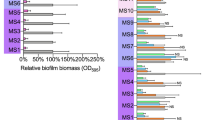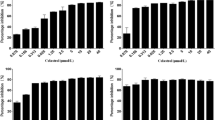Abstract
Bacterial biofilms are associated with chronic infections due to their resistance to antimicrobial agents. Staphylococcus aureus is a versatile human pathogen and can form biofilms on human tissues and diverse medical devices. To identify novel biofilm inhibitors of S. aureus, the supernatants from a library of 458 Actinomycetes strains were screened. The culture supernatants (1% v/v) of more than 10 Actinomycetes strains inhibited S. aureus biofilm formation by more than 80% without affecting the growth. The culture supernatants of these biofilm-reducing Actinomycetes strains contained a protease (equivalent to 0.1 μg proteinase K ml−1), which both inhibited S. aureus biofilm formation and detached pre-existing S. aureus biofilms. This study suggests that protease treatment could be a feasible tool to reduce and eradicate S. aureus biofilms.



Similar content being viewed by others
References
Bakkiyaraj D, Pandian SK (2010) In vitro and in vivo antibiofilm activity of a coral associated actinomycete against drug resistant Staphylococcus aureus biofilms. Biofouling 26:711–717
Boles BR, Horswill AR (2008) Agr-mediated dispersal of Staphylococcus aureus biofilms. PLoS Pathog 4:e1000052
Boles BR, Horswill AR (2011) Staphylococcal biofilm disassembly. Trends Microbiol 19:449–455
Costerton JW, Stewart PS, Greenberg EP (1999) Bacterial biofilms: a common cause of persistent infections. Science 284:1318–1322
DeLong EF (1992) Archaea in coastal marine environments. Proc Natl Acad Sci USA 89:5685–5689
Hentzer M et al (2002) Inhibition of quorum sensing in Pseudomonas aeruginosa biofilm bacteria by a halogenated furanone compound. Microbiology 148:87–102
Hoffman LR, D’Argenio DA, MacCoss MJ, Zhang Z, Jones RA, Miller SI (2005) Aminoglycoside antibiotics induce bacterial biofilm formation. Nature 436:1171–1175
Iwase T et al (2010) Staphylococcus epidermidis Esp inhibits Staphylococcus aureus biofilm formation and nasal colonization. Nature 465:346–349
Lesic B et al (2007) Inhibitors of pathogen intercellular signals as selective anti-infective compounds. PLoS Pathog 3:1229–1239
Lowy FD (1998) Staphylococcus aureus infections. N Engl J Med 339:520–532
McNeil MM, Brown JM (1994) The medically important aerobic actinomycetes: epidemiology and microbiology. Clin Microbiol Rev 7:357–417
O’Gara JP (2007) ica and beyond: biofilm mechanisms and regulation in Staphylococcus epidermidis and Staphylococcus aureus. FEMS Microbiol Lett 270:179–188
Pratt LA, Kolter R (1998) Genetic analysis of Escherichia coli biofilm formation: roles of flagella, motility, chemotaxis and type I pili. Mol Microbiol 30:285–293
Quiblier C, Zinkernagel AS, Schuepbach RA, Berger-Bächi B, Senn MM (2011) Contribution of SecDF to Staphylococcus aureus resistance and expression of virulence factors. BMC Microbiol 11:72
Sauer K, Cullen MC, Rickard AH, Zeef LAH, Davies DG, Gilbert P (2004) Characterization of nutrient-induced dispersion in Pseudomonas aeruginosa PAO1 biofilm. J Bacteriol 186:7312–7326
Stewart PS, Costerton JW (2001) Antibiotic resistance of bacteria in biofilms. Lancet 358:135–138
Tamaoka J, Komagata K (1984) Determination of DNA base composition by reversed-phase high-performance liquid chromatography. FEMS Microbiol Lett 25:125–128
Vuong C, Saenz HL, Götz F, Otto M (2000) Impact of the agr quorum-sensing system on adherence to polystyrene in Staphylococcus aureus. J Infect Dis 182:1688–1693
You J et al (2007) Inhibition of Vibrio biofilm formation by a marine actinomycete strain A66. Appl Microbiol Biotechnol 76:1137–1144
Acknowledgments
This research was supported by the Yeungnam University research grant. J.-H. Park was supported by the Human Resources Development Program of Korea Institute of Energy Technology Evaluation and Planning (KETEP) grant (No:20104010100580) funded by the Korean Ministry of Knowledge Economy.
Author information
Authors and Affiliations
Corresponding author
Electronic supplementary material
Below is the link to the electronic supplementary material.
Rights and permissions
About this article
Cite this article
Park, JH., Lee, JH., Kim, CJ. et al. Extracellular protease in Actinomycetes culture supernatants inhibits and detaches Staphylococcus aureus biofilm formation. Biotechnol Lett 34, 655–661 (2012). https://doi.org/10.1007/s10529-011-0825-z
Received:
Accepted:
Published:
Issue Date:
DOI: https://doi.org/10.1007/s10529-011-0825-z




